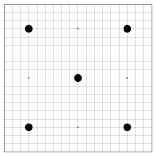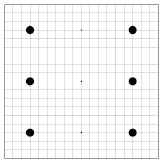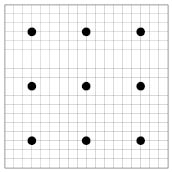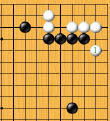Haengma (K)
K-Çึ (ú¼Ø©)
A term that considers a placement of a stone as a movement in relation to stones already played.
This term is used only in Korea; it literally means ¡®movement of the horse.¡¯ In the Korean terminology of games, a ¡®horse¡¯ refers to a game¡¯s playing piece. In go, it is a stone. Although there is no movement in go, only placements, Korean players noticed the importance of the relationships between stones and invented this concept.
In Go, every move is a ¡®placement,¡¯ so the evaluation of a move is based on each placement and, only after the concept of ¡®shape¡¯ is introduced, does it become possible to estimate the value of a move in the context of their relationships among different placements. The concept of shape allows only a static understanding. With the concept of ¡®haengma,¡¯ moves can be understood as something dynamic. Because of this, various evaluations such as ¡®fast/slow,¡¯ ¡®light/heavy,¡¯ etc., become possible.
 Dia. 1
Dia. 1  Dia. 2
Dia. 2
 Dia. 3
Dia. 3  Dia. 4
Dia. 4
Comparing to the jump in Dia. 2, White¡¯s diagonal move with 1 in Dia. 1 is a good haengma, since it absolutely separates the black stone on the right from its allies on the lef, as is illustrated in Dia. 3, and helps the white stone get out into the center. White 1 in Dia. 2 does not separate the black stones and is shown in Dia. 4.
Half a point
J-hanmoku (ÚâÙÍ), C-banmu (ÚâÙÍ)£¬K-¹Ý(Úâ)Áý
An artificial convention used to avoid draws.
For example, when there is a compensation of 6.5 points is given to White and Black wins 6 points on board, the extra half point decides the game as White¡¯s victory.
It is artificial because it is impossible to physically make half a point of territory on the board. It is possible that a move has value of half a point, as seen in half-point kos. In this sense, there can be a third of a point, a quarter of a point, etc.
Half-eye
J-hangan (ÚâäÑ), C- banzhiyan (ÚâñþäÑ)£¬K-¹Ý´«
An eye shape that needs one more play to be a complete eye.
 Dia. 1
Dia. 1
In Dia. 1, ¡®a¡¯ is a half-eye because it can become either a false eye or a complete eye depending on whether the point ¡®b¡¯ is played by White or Black.
 Dia. 2
Dia. 2  Dia. 3
Dia. 3
In this way, ¡®a¡¯ and ¡®b¡¯ in Dia. 2 are half-eyes, so the white stones have one perfect eye and two half-eyes. The white stones are, therefore, alive without adding a move because White can make one more complete eye out of the two half-eyes. For example, if Black plays 1 in Dia. 3 White will make an eye with 2.
Half-point game
J-hanmoku shobu (ÚâÙÍãݶ), C-banmu shengfu (ÚâÙÍ??)£¬K-¹Ý(Úâ)Áý ½ÂºÎ(ãݶ)
It means literally a game that is decided by a half point. But, rhetorically it refers to a game that is very close.
Half-point Ko
J-hanko (Úâ̤), C-dajie (?̤)£¬K-¹Ý(Úâ) ÆÐ
A ko that is worth half a point.
 Dia. 1
Dia. 1
The ko in Dia. 1 is an example of a halp-point ko. Since Black needs two moves to win the ko, one for capturing a stone and another one for ending the ko, it takes two moves to gain a point. As a result, the value of each move is half a point. If the marked white stone were not present, the value of this ko would increase.
Handicap Game
J-okigo (öÇѳ), C-rangzi qi (?íѤ)£¬K-Á¢¹ÙµÏ
In Go, if the players differ in strength, the weaker player puts stones on the star points before the game starts to compensate for the difference, i.e. to have an equal chance to win.
Traditionally, there are nine methods for the placement of handicap stones.








Hand Talk
J-shudan (â¢ÓÈ), C-shoutan (â¢ÓÈ), K-¼ö´ã(â¢ÓÈ)
A metaphorical name for Go, which means that a conversation is possible by playing a game of Go even without language. The Chinese chraters ¡®â¢ÓÈ¡¯ literally mean ¡®a conversation with hands.¡¯
Hanging connection
See tiger¡¯s connection.
Hankuk Kiwon (K)
K-Çѱ¹±â¿ø (ùÛÏÐѤêÂ)
The Korean Baduk Association.
Hankuk Kiwon was founded in 1955. It administers all the Go playing communities in Korea, organizes all types of Go events, and, in general, promotes Go. It has more than 200 professinal players, and there happen more than twenty professional tournaments every year.
Head
J-atama (Ôé), C-tou (?)£¬K-¸Ó¸®
The stone located at the front of stones in line, usually toward the center, when stones of both players are lined against each other.
Head of two stones
J-nimoku no atama ( ì£ÙͪÎÔé), C-erzi tou (ì£í?), K-µÎ Á¡ ¸Ó¸®
The stone at White 1 in Dia. 1 is called the ¡®head of two stones.¡¯
 Dia. 1
Dia. 1
It is good to bend at the head of these two stones with Black 1 as shown in Dia. 2. There is a saying ¡®hit the head of two stones,¡¯ which refers to Black 1 in this position.
 Dia. 2
Dia. 2
Head of three stones
J-sanmoku no atama ( ß²ÙͪÎÔé), C-sanzi tou (ß²í?), ,K-¼¼ Á¡ ¸Ó¸®
White 1 in Dia. 1 is called the ¡®head of the three stones.¡¯
 Dia. 1
Dia. 1
It is also good to hit the the head of these three stones with Black 1 as in Dia. 2.
 Dia. 2
Dia. 2
Heavy
J-omoi (ñ쪤), C-zhong (ñì)£¬K-¹«°Ì´Ù
A state of stones that lacks eye shape, is too big to be sacrificed, and is vulnerable to an attack.
 Dia. 1
Dia. 1  Dia. 2
Dia. 2
The white stones in Dia. 1 are very heavy. White should have done something, for example 1 and 3 in Dia. 2 to avoid this result.
Opp. light
High
J-takai (ÍÔ), C-gao (ÍÔ)£¬K-³ô´Ù
A term describing the position of stones which are located on the fourth or fifth line.
The position of the white stones in Dia. is high. Although White seems to have a great potential to make a big territory, the framework is vulnerable to an invasion. For example, at ¡®a¡¯, ¡®b¡¯ and ¡®c.¡¯
 Dia. 1
Dia. 1
Honinbo (J)
J-honinbo (Üâì×Û©), C-benyinfang (Üâì×Û©), K-º»Àιæ (Üâì×Û©)
Originally, it was the name of a pagoda in the grounds of the Jakkoji Temple in Kyoto. It has been used as the hereditary name of one of the four official Japanese Go schools in the Edo period. It is now the name of a Japanese tournament.
Hug
J-kakae (øÙª¨), C-baochi (øÙýÞ), K-²¸¾È´Ù
A move that grips a single opposing stone.
 Dia. 1
Dia. 1
White 1 in Dia. 1 hugs the isolated black stone.
Illegal move
J-chakushu kinshiten (ó·â¢Ð×òïÃ), C-jinru dian (Ð×ìýïÃ), K-Âø¼ö±ÝÁöÁ¡ (ó·â¢Ð×òïÃ)
It is forbidden for White to play at ¡®a¡¯ in Dia. 1, because his stones would not have any liberties. The move at ¡®a¡¯ is called a ¡®suicide move.¡¯ If a player plays an illegal move, he loses the game.
 Dia. 1
Dia. 1
However, if White can capture the opponent¡¯s stones by playing at ¡®a¡¯ in Dia. 2, then it is allowed to play there and capture the two black stones.
 Dia. 2
Dia. 2
It is just natural for a player not to play this suicidal move, so it may seem to be absurd to make a rule about it. It seems to be just okay that the opponent takes off the stones without liberty and also has the turn to play. But, if there were no rule about this, there could arise a situation in which players purposely play this kind move. For example, the black stones in Dia. 3 are alive, because it is illegal for White to play at ¡®a.¡¯ However, if White were able to play 1 as shown in Dia. 4, Black would capture the three white stones and could then play at ¡®a¡¯ in Dia. 5. Therefore, Black has to spend a move playing at ¡®a¡¯ to make two separate eyes for the black stones. That is, if White ¡®a¡¯ is not forbidden, White could use it as a ko threat. So, it is necessary to rule that a suicide move is illegal.
 Dia. 3
Dia. 3  Dia. 4
Dia. 4  Dia. 5
Dia. 5
Influence
J-gaisei (èâá§), C-waishi (èâ?)£¬K-¼¼·Â (á§Õô)
A relatively large potential built by stones strongly connected on the outside. It used to get the advantage with respect to the whole-board.
The opposite concept is ¡®profit.¡¯ While profit is usually made in the corners and on the sides, influence is made toward the center where the potential can be most powerful. Stones emanating influence are usually located on the 4th line and higher.
It is also called ¡®outside influence.¡¯ Each stone on board has its influence. However, only when the power is big enough to help the other stones in attacking the enemy, building territory, etc., can it be referred to as ¡®influence.¡¯
 Dia. 1
Dia. 1
In Dia. 1, White¡¯s stones are radiating influence toward the left side and the center, while Black has made profit at the top.
Internal ko threat
J-sobako (ö°ª³ª¦), C-benshen jie (Üâãó̤)£¬K-ÀÚü(í»ô÷)ÆÐ
A ko threat that is made against the group in which the ko is being fought. It cannot be ignored because ignoring it makes winning the ko useless.
 Dia. 1
Dia. 1
Black 2 in Dia. 1 is an example of an internal ko threat. If White ignores it and connects at ¡®a¡¯, Black can capture the three white stones in the corner by playing ¡®b,¡¯ save his own group as well.
Internal liberty
See inside liberty
Intuition
J-kankaku (ÊïÊÆ), C-ganjue (Êï?)£¬K-°¨°¢ (ÊïÊÆ)
The intuitive ability to find good moves in a position, not through logical analysis.
Invade
J-uchikomi (öèªÁ?ªß), C-daru (öèìý), K-ħÀÔ(öÕìý)ÇÏ´Ù
To go into the opponent¡¯s framework or influence in order to prevent it from becoming a settled territory.
White 1 in the digram below is an example.
 Dia. 1
Dia. 1
Iron pillar
J-tetchu (ôÑñº), C-yuzhu (è¬ñº), K-öÁÖ(ôÑñº)
A descent from a stone on the fourth line to the third line to secure one¡¯s territorial framework against the opponent¡¯s invasion.
 Dia. 1
Dia. 1  Dia. 2
Dia. 2
Jaw attack
J-ago (äÉ), C-no, K-ÅιØ
An attack that breaks the eye shape of the opponent¡¯s stones by making a move where the opponent can make a tiger¡¯s mouth.
 Dia. 1
Dia. 1
It is distinguished from sideburn which strikes from above.
Cf. sideburn
Joseki (J)
See pattern
Jump
J-tobu (Þ«ªÖ), C-tiao (Ô¯), K-¶Ù´Ù
To skip one or more lines toward the center.
Cf. jump ahead
One-space jump
J-ikken tobi (ìéÊàÞ«ªÓ), C-yi jian tiao (ìé?Ô¯), K-ÇÑ Ä ¶Ü
White 1 in Dia. 1 is a one-space jump from the marked white stone. This is the basic form of ¡®jump.¡¯
 Dia. 1
Dia. 1
Two-space jump
J-niken tobi (ì£ÊàÞ«ªÓ), C-er jian tiao (ì£?Ô¯), K-µÎ Ä ¶Ü
White 1 in Dia. 1 is a two-space jump from the marked white stone.
 Dia. 1
Dia. 1
Knight¡¯s jump
A knight¡¯s move played toward the center.
 Dia. 1
Dia. 1
Jump in
J-tobikomi (Þ«ªÓ?ªß), C-tiaoru (Ô¯ìý), K-¶Ù¾î µé¾î°¡´Ù
To jump into the opponent¡¯s territory.
 Dia. 1
Dia. 1
Jump out
J-tobidashi (Þ«ªÓõóª·), C-tiaochu (Ô¯õó), K-¶Ù¾î ³ª°¡´Ù
To jump especially from a stone in the opponent¡¯s area.
 Dia. 1
Dia. 1
Jump ahead
No J, no C, K-°Ç³Ê¶Ù´Ù
A jump along the side passing by the opponent¡¯s stone.
 Dia. 1
Dia. 1
In Dia. 1, Black 1 jumps ahead the marked white stone.
Jungsuk (K)
See pattern
Kajiwara pattern
Ú²ê«ïÒà´
A pattern which was invented by the Japanese 9 dan, Kajiwara Takeo(Ú²ê«Ùëê©). It is characterized by the large diagonal move with White 2 in Dia. 1 after Black pincers with 1. The purpose of this move is to make an outside wall while giving the corner profit to the opponent as shown in Dia. 2.
 Dia. 1
Dia. 1  Dia. 2
Dia. 2
Key stone
J-kaname-ishi(é©à´) / tane-ishi (ðúà´), C-qijin (ѤÐÉ), K-¿ä¼® (é©à´)
A stone (or stones) that seems to be unimportant and disposable, but actually plays a tactically important function, such as dividing the opponent¡¯s stones.
 Dia. 1
Dia. 1
In Dia. 1, the three marked white stones are too important to sacrifice because they cut Black¡¯s group into two.
Kill
J-korosu (߯ª¹), C-sha (?), K-Àâ´Ù
To deprive the opponent of the means to live by taking away all his liberties as in Dia. 1, preventing him from making two separate eyes as in Dia. 2, or robbing him of a base as in Dia. 3.
 Dia. 1
Dia. 1  Dia. 2
Dia. 2  Dia. 3
Dia. 3
In particular, it is also called ¡®capture¡¯ when a player kills the opponent¡¯s stones by blocking all of their liberties and taking them off the board.
Knight¡¯s move
J-keima (ÌýØ©), C-fei (Þ«), K-³¯ÀÏÀÚ [ìí]
A move that makes the same shape with a related stone as the ¡®knight¡¯ does in chess when it moves, or the shape made by a knight¡¯s move.
 Dia. 1
Dia. 1
This matches the Japanese usage, where the Japanese term ¡®keima¡¯ comes from shogi (íâѤ), Japanese chess. Keima is a piece equivalent to the knight in chess. We also find the same kind of coinage with the Chinese ¡®elephant¡¯s move(ßÚÜÆÞ«).¡¯ In Chinese chess, the elephant moves in the large diagonal shape.
On the other hand, the Korean ¡®³¯ÀÏÀÚ¡¯ refers to the Chinese character ¡®ìí.¡¯ Koreans noticed the fact that the lines related to the knight¡¯s move looks the same as the Chinese character ¡®ìí¡¯ as shown in Dia. 2. The Korean terminology also has terms borrowed from the Chinese characters, such as ¡®ÀÔ±¸ÀÚ-Ï¢,¡¯ ¡®´«¸ñÀÚ-ÙÍ,¡¯ ¡®¹çÀüÀÚ-ï£,¡¯ that refer to ¡®diagonal move,¡¯ ¡®large knight¡¯s move,¡¯ and ¡®large diagonal move¡¯ respectively.
 Dia. 2 (±×¸²¿¡ ³¯ÀÏÀÚ Ç¥½ÃÇÒ °Í)
Dia. 2 (±×¸²¿¡ ³¯ÀÏÀÚ Ç¥½ÃÇÒ °Í)
Knight¡¯s approach
See approach.
Knight¡¯s cap
See cap.
Knight¡¯s connection
See connect.
Knight¡¯s crossing
See cross.
Knight¡¯s enclosure
See enclose.
Knight¡¯s jump
See jump.
Knight¡¯s slide
See slide.
Knot
J-fushi (ï½), C-duandian (?ïÃ), K-¸Åµì
A shape possessing cutting points created by a wedge as in Dia. 1.
 Dia. 1
Dia. 1  Dia. 2
Dia. 2
White leaves cutting points at ¡®a¡¯ and ¡®b¡¯ in Black¡¯s shape by making a knot with 1 and 3 in Dia. 1, instead of peeping with 1 as in Dia. 2.
Ko (J)
J-ko (̤), C-jie (̤), K-ÆÐ
A situation where a stone is in atari as soon as it captures as the marked white stone in Dia. 1 and apparently can be recaptured by the opponent with Black 1 in Dia. 2.
However, the opponent¡¯s recapturing stone also is in atari, so it can be recaptured with White 1 in Dia. 4. Therefore, the ko situation can repeat endlessly. In Go, the rules forbid recapture on the next move.
 Dia. 1
Dia. 1  Dia. 2
Dia. 2
 Dia. 3
Dia. 3  Dia. 4
Dia. 4
Direct ko
J-honko(Üâ̤) / iteko(ìéâ¢Ì¤), C-yishou jie (ìéâ¢Ì¤), K-´Ü(Ó¤)ÆÐ
The simplest form of ko in which no extra moves or steps are needed to win the ko.
The other complicated forms of ko can be distinguished by an English word ¡®indirect ko¡¯ but there is no equivalance to this ¡®indirect¡¯ in Asian terminology.
Cf. approach-move ko, n-step ko.
Kobayashi opening
J-kobayashi ryu (á³×ù×µ), C-xiaolin liu (á³×ù×µ), K-°í¹Ù¾ß½Ã·ù(á³×ù×µ)
An opening style that was developed and played by the Japanese 9 dan, Kobayashi Koichi(á³×ùÎÃìé), characterized with Black 3, 5, and 7 in diagrams below.


Ko threat
J-kodate (̤ءªÆ), C-jiecai (̤î§)£¬K-Æа¨
A move used in fighting a ko that forces the opponent to answer instead of ending the ko.
If the opponent ignores the ko threat, the other side takes the profit made from it; if the opponent defends, the other side recaptures the ko.
Kyu
J-kyu (Ðä), C-ji (?), K-±Þ(Ðä)
A Japanese pronunciation for the Chinese Character ¡®Ðä,¡¯ which refers to the amateur ranking scale below dan(Ó«).
1st kyu is the highest.






